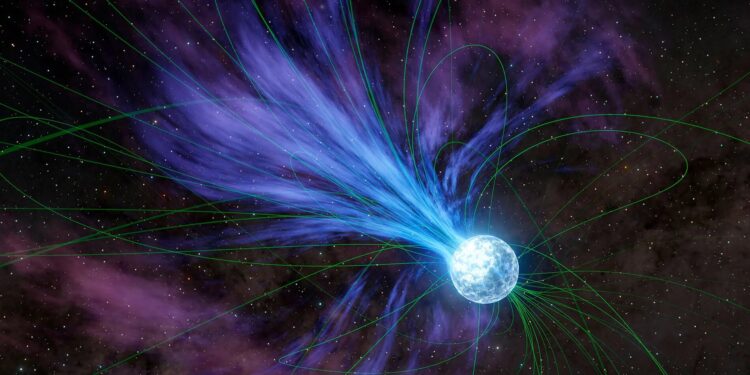In an ejection that would have slowed its rotation, a magnetar is shown losing matter into space in this artist’s concept. The magnetar’s strong, twisted magnetic field lines (shown in green) can influence the flow of electrically charged matter coming from the object, which is a type of neutron star. Credit: NASA/JPL-Caltech
What causes mysterious radio wave explosions from deep space? Astronomers may be close to providing an answer to this question. Two NASA X-ray telescopes recently observed one of these events, known as a fast radio burst, just minutes before and after it occurred. This unprecedented insight puts scientists on the path to better understanding these extreme radio events.
Even though they only last a fraction of a second, fast radio bursts can release as much energy as the sun does in a year. Their light also forms a laser-like beam, distinguishing them from more chaotic cosmic explosions.
Because the bursts are so brief, it is often difficult to determine where they are coming from. Before 2020, those traced to their source came from outside our own galaxy, too far away for astronomers to see what created them. Then a rapid radio burst erupted in Earth’s home galaxy, coming from an extremely dense object called a magnetar, the collapsed remains of an exploded star.
In October 2022, the same magnetar, called SGR 1935+2154, produced another fast radio burst, this one studied in detail by NASA’s NICER (Neutron Star Interior Composition Explorer) on the International Space Station and NuSTAR (Nuclear Spectroscopic Telescope Array) at low temperature. Earth orbit.
The telescopes observed the magnetar for hours, providing insight into what happened on the source object’s surface and its immediate surroundings before and after the fast radio burst. The results, described in a new study published in the journal Natureare an example of how NASA telescopes can work together to observe and track short-lived events in the cosmos.
The burst occurred between two glitches when the magnetar suddenly started spinning faster. SGR 1935+2154 is estimated to be about 20 kilometers in diameter and spinning about 3.2 times per second, meaning its surface was moving at about 7,000 mph (11,000 km/h). Slowing it down or speeding it up would require a significant amount of energy.
That’s why the study authors were surprised to find that between two glitches, the magnetar slowed down to a speed lower than its pre-glitch speed in just nine hours, or about 100 times faster than that. which has never been observed in a magnetar.
“Typically, when problems occur, it takes weeks or months for the magnetar to return to its normal speed,” said Chin-Ping Hu, an astrophysicist at the National Changhua University of Education in Taiwan and lead author of the new study. “So it’s clear that things are happening with these objects on much shorter timescales than we previously thought, and that might be related to how quickly the radio bursts are generated.”
Spin cycle
When trying to understand exactly how magnetars produce fast radio bursts, scientists must consider many variables.
For example, magnetars (which are a type of neutron star) are so dense that a teaspoon of their material would weigh about a billion tons on Earth. Such a high density also means a strong gravitational pull: a marshmallow falling on a typical neutron star would impact with the force of an early atomic bomb.
Strong gravity means that a magnetar’s surface is a volatile place, regularly releasing bursts of higher-energy X-rays and light. Before the fast radio burst in 2022, the magnetar began releasing bursts of X-rays and gamma rays (even more energetic wavelengths of light) that were observed in the peripheral vision of high-energy space telescopes . This increase in activity prompted mission operators to point NICER and NuSTAR directly at the magnetar.
“All of these X-ray bursts that occurred before this problem would have had, in principle, enough energy to create a fast radio burst, but they didn’t,” said Zorawar Wadiasingh, co-author of study and researcher at the University of Maryland, College Park and NASA’s Goddard Space Flight Center. “So it appears that something changed during the downturn, creating the right conditions.”
What else could have happened with SGR 1935+2154 to produce a fast radio burst? One factor could be that the exterior of a magnetar is solid and the high density crushes the interior into a state called superfluid. Sometimes the two can get out of sync, like water sloshing around inside a spinning fishbowl. When this happens, the fluid can provide energy to the crust. The authors of the paper believe this is likely what caused the two problems that limited the fast radio burst.
If the initial problem had caused a crack in the magnetar’s surface, it could have released material from the star’s interior into space, like a volcanic eruption. The loss of mass causes rotating objects to slow down, so the researchers believe this could explain the magnetar’s rapid deceleration.
But having observed only one of these events in real time, the team still cannot say with certainty which of these factors (or others, such as the magnetar’s powerful magnetic field) might lead to the production of ‘a rapid radio burst. Some might not be connected to the burst at all.
“We definitely observed something important for our understanding of fast radio bursts,” said George Younes, a Goddard researcher and member of the NICER science team specializing in magnetars. “But I think we still need a lot more data to unravel the mystery.”
More information:
Chin-Ping Hu, rapid rotational changes around a fast magnetar radio burst, Nature (2024). DOI: 10.1038/s41586-023-07012-5. www.nature.com/articles/s41586-023-07012-5
Quote: NASA telescopes find new clues to mysterious deep space signals (February 14, 2024) retrieved February 14, 2024 from
This document is subject to copyright. Apart from fair use for private study or research purposes, no part may be reproduced without written permission. The content is provided for information only.



